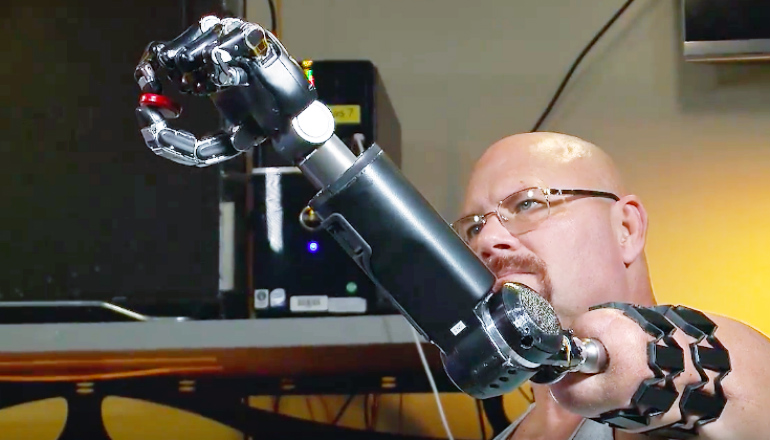Medical device and MedTech insights, news, tips and more
Man Maneuvers Robotic Arm With His Thoughts
January 15, 2016


The new system is a game changer, test patient Johnny Matheny says. “Before, I had limited range,” he says. “I couldn’t reach over my head and behind my back. Now—boom!—that limitation is gone.” (Credit: JHUAPL)
Surgeons used a new technique to attach a thought-controlled robot arm directly to an amputee’s stump, giving him a far greater range of motion with the advanced prosthetic limb.
The system, involving an implant inserted into the bone at the end of the residual limb, allows test patient Johnny Matheny to use the arm without the constraining and sometimes uncomfortable harness he previously used when experimenting with the Modular Prosthetic Limb (MPL).
“It’s all natural now,” Metheny says after his first trial run using the MPL with the new implant. “Nothing is holding me down. Before, I had limited range; I couldn’t reach over my head and behind my back. Now—boom!—that limitation is gone.”
That surgery is what makes it possible for him to use and control an advanced prosthetic device like the MPL much as a non-amputee would use an arm: the brain send signals through the nerves to direct movement.
The combination in Matheny of both the reinnervation and the implanted connection system is another first for the Revolutionizing Prosthetics program, a Defense Department-funded effort led by the Applied Physics Laboratory. The goal is to provide better functionality for soldiers and for civilian amputees as well.
THE SOCKET IS CRITICAL
“This accomplishment has eliminated one of the biggest gaps in prosthetic development: the socket,” says Michael McLoughlin, chief engineer in APL’s Research and Exploratory Development Department.
The socket—the part of the prosthesis adjacent to the stump—is critical. If it doesn’t fit correctly, the patient can experience pain, sores and blisters, and the prosthesis will feel heavy and cumbersome, says Courtney Moran, a clinical prosthetist who works closely with patients. Even with well-designed sockets, patients have problems with heat, sweating, and chafing, Moran says.
Read More & See the Video – Source: Man maneuvers robotic arm with his thoughts – Futurity
Posted by Paulette Campbell-Johns Hopkins on
Source: Johns Hopkins University
**There have been no adjustment to the article from the original source at Futurity
